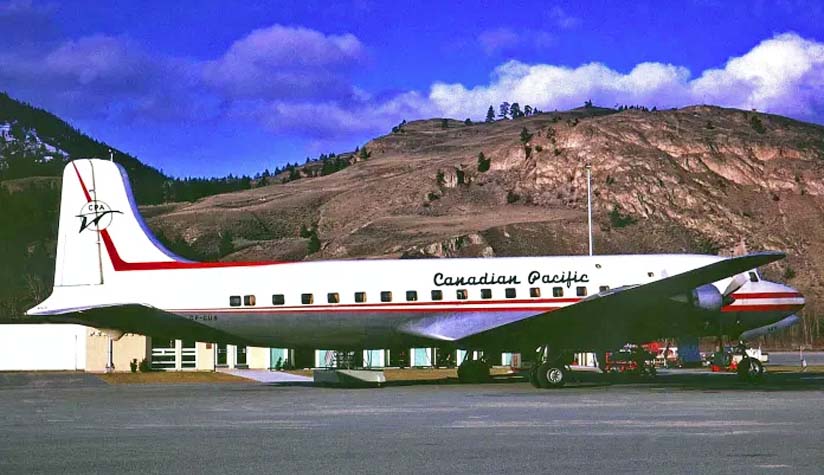

Canada - Today in Aviation, after the Canadian Pacific Railway Company (CP) decided to purchase ten small bush airlines, Canadian Pacific
Airlines (CPAL) is born.
This is the story of how this once well known airline began.
In the early 1940s, CP decides to purchase Ginger Coote Airways, Southern Air Transport, Wings, Prairie Airways, Mackenzie Air Services, Arrow Airways,
Starratt Airways, Quebec Airways, and Montreal & Dominion Skyways.
The purpose becomes clear when a larger airline, Canadian Airways, is added to the lot and a brand new airline is brought into being, CPAL.
At the helm of the new airline, there are no real businessmen, but people with a vision and courage, comprised mostly of bush pilots and flying
pioneers.
Among them, Grant McConachie, the first CP CEO, Punch Dickins, and Wop May stand out.
International Expansion
In 1949, McConachie obtained landing rights at Tokyo (HND) and Hong Kong (HKG), and this opened the door to CPAL successful transpacific flights to Australia,
Asia, and the South Pacific.
In 1968 CPAL is re-branded CP Air.
CP becomes Canadian Pacific Ltd. (1971) and CP creates the "Multimark" design, joining the other CP brands, CP Hotels, CP Ships, CP Transport, and
later on, CP Rail.
The carrier, the second largest airline in Canada, had to face a strong competitor, government owned and financed Trans-Canada Airlines, the precursor of Air
Canada (AC), on international and transcontinental routes.
A merger is attempted several times but CP keeps going on its own, notwithstanding government-imposed limitations on possible destinations.
Worldwide Reach
CPAL's strong growth is made possible by the development of the polar route, which puts the airline, based in Vancouver (YVR), in an ideal position to exploit
the Far East routes while the airline also secured rights to fly to Amsterdam (AMS), Australia, HKG, and Shanghai (SHA), and revenue grew from US$3 million in
1942 to US$63 million in 1964.
Flights to Sydney via stops in Honolulu (HNL), HKG via HND, with technical landing at Shemya Island (SYA), started in 1949, flown by the Canadian version of
the DC-4, the Canadair North Star aircraft, while the Douglas DC-4 took over in 1951, and Douglas DC-6Bs in 1953.
Flights to Lima (LIM) begin in 1953 and extended to Buenos Aires (EZE) in 1956.
Services to to AMS begin in 1955 and in August 1956 three Douglas DC-6B weekly flights depart YVR for AMS.
The same year two flights are operated from YVR to HND and HKG, one to Auckland (AKL), one to Sydney (SYD), and one to EZE.
From an International Timetable in 1959, the following appear to be the main routes flown by CP:
Flight CP1 and CP2, from HKG, HND, YVR, Edmonton (YEG) - Winnipeg (YWG), Toronto (YYZ), Montreal (YUL).
Flight CP301/302, from SYD Nadi (NAN), HNL, YVR, YEG, and non-stop via the Polar route to AMS.
Other flights to Europe included Lisbon (LIS), Milan (MXP), Rome (FCO), and Athens (ATH).
Flight CP401/402, from YVR, Mexico City (MEX), LIM, Santiago (SCL), and EZE.
Flight CP501/502, from MEX YYZ, Santa Maria (SMA), Azores Island LIS, Madrid (MAD).
Aircraft Fleet
In 1958, the CP fleet evolved from using DC-4 and DC-6 to using the Bristol Britannia, a British built turboprop aircraft, though the latter was quickly
replaced by a jet aircraft, the Douglas DC8.
Still, the Bristol Britannia continued to fly until the middle of 1965 to destinations not suited for the new DC8.
The year 1970 saw the arrival of the Boeing 727 and 737 as well the entry into service of the stretched DC8-63, named the Spacemaster by CP.
Final Days
A massive fleet renewal, a need to fight competition from Air Canada under the Open Skies' new route distribution, debt, and a market downturn, were all fatal
to CP' financial health.
In 1986, CP Air reverted to its old brand name and became again Canadian Pacific Airlines with a new logo and color scheme.
The CP avatar had a short life, and in 1987, the airline was sold to Pacific Western Airlines (PWA) for just US$300 million with the buyer absorbing the loss
carried by CP, which at the time amounted to US$600 million.
The brand name changed into Canadian Airlines International (CP), but in 2000, the new CP was finally taken over and merged with Air Canada.
Mario Bertoletti.
(because there was no image with original article)
(usually because it's been seen before)
provisions in Section 29 of the Canadian
Copyright Modernization Act.
